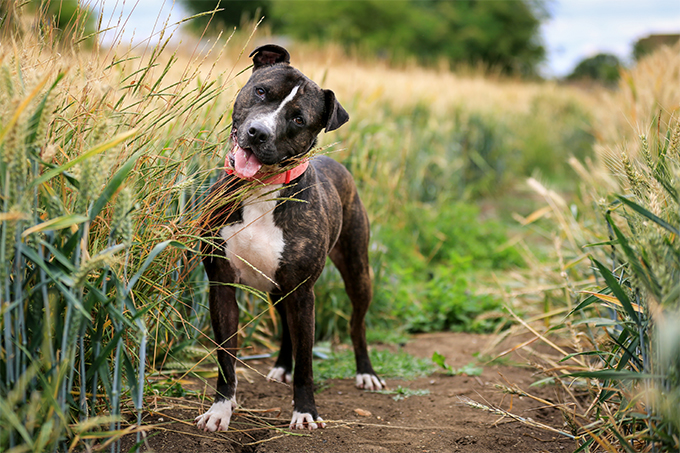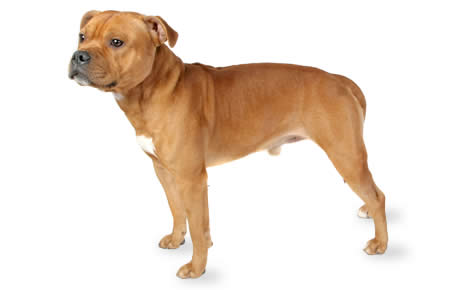Although they were created in 19th-century Britain to be a small, fast fighting dog, those days are long past. The Staffordshire Bull Terrier dog breed of today is a fine companion known for their courage, intelligence, and love of children.
Fans of the breed lovingly refer to them as Staffy for short. Even though these are purebred dogs, you may find them in the care of shelters and rescue groups. Remember to adopt! Don’t shop if you want to bring one of these dogs home.
Despite their affectionate and playful nature, Staffies do best with experienced pet parents who can socialize them early and keep up with consistent training. Meet the breed’s needs, and you’ll have a faithful, adoring member of the family.
See below for full list of dog breed traits and facts about Staffordshire Bull Terriers!
Staffordshire Bull Terrier Dog Breed Pictures
Adaptability
-
Adapts Well To Apartment Living
Looking for the best dog for your apartment? Contrary to popular belief, the suitability of dogs who adapt well to apartment living goes beyond its size. Apartment dwellers have a myriad of dog breeds to choose from as potential companions, with various factors to consider. Some large breeds can adapt well to apartment living and have lower activity levels. Others may require more space and possess higher energy levels. On the other hand, certain small dog breeds with abundant energy can still find contentment with indoor playtime or brisk walks.
However, when selecting a dog that adapts well apartments, it is essential to prioritize your neighbors. Opting for a pet that doesn’t excessively bark and behaves politely when encountering others in shared spaces like is crucial for maintaining a harmonious apartment environment.
In high-rise settings, it’s worth noting that numerous small dogs may exhibit a propensity for high energy and frequent barking. This makes them less suitable for apartment living. Therefore, desirable qualities in an apartment dog encompass being quiet, low-energy, and displaying polite behavior towards other residents.
Factors To Consider When Choosing A Dog For An Apartment
When considering dogs that adapt well to apartments, size alone should not be the sole determinant. Apartment dwellers have a wealth of dog breeds to choose from as potential furry companions. It’s important to remember that the size of your living space is just one factor to consider. While some larger breeds can adapt well to apartment living, with lower, others may require more space and have higher energy levels, making them less suitable for smaller apartments. Conversely, certain small dog breeds with higher energy levels can still thrive in apartments, finding contentment through indoor playtime or brisk walks. However, it is crucial to consider your neighbors’ comfort when selecting a dog. Opt for a pet that doesn’t bark excessively and behaves politely when interacting with others in shared spaces.
Therefore, it’s important to prioritize qualities such as being quiet, low-energy, calm indoors, and exhibiting good manners when living in close proximity to other residents. By considering these factors, you can find a dog that will adapt well to apartment living and create a harmonious living environment for everyone involved.
-
Good For Novice Owners
Some dogs are simply easier than others; they take to training better and are fairly easygoing. They’re also resilient enough to bounce back from your mistakes or inconsistencies.
Dogs who are highly sensitive, independent thinking, or assertive may be harder for a first-time dog parent to manage. You’ll get your best match if you take your dog-owning experience into account as you choose your new pooch.
If you’re new to dog parenting, take a look at 101 Dog Tricks and read up on how to train your dog!
-
Sensitivity Level
Some dogs will let a stern reprimand roll off their backs, while others take even a dirty look to heart. Low-sensitivity dogs, also called “easygoing,” “tolerant,” “resilient,” and even “thick-skinned,” can better handle a noisy, chaotic household, a louder or more assertive owner, and an inconsistent or variable routine. Do you have young kids, throw lots of dinner parties, play in a garage band, or lead a hectic life? Go with a low-sensitivity dog.
-
Tolerates Being Alone
Some breeds bond very closely with their family and are more prone to worry or even panic when left alone by their owner. An anxious dog can be very destructive–barking, whining, chewing, and otherwise causing mayhem. These breeds do best when a family member is home during the day or if you can take the dog to work.
-
Tolerates Cold Weather
Breeds with very short coats and little or no undercoat or body fat, such as Greyhounds, are vulnerable to the cold. Dogs with a low cold tolerance need to live inside in cool climates and should have a jacket or sweater for chilly walks. You can find a great jacket for your dog here!
-
Tolerates Hot Weather
Dogs with thick, double coats are more vulnerable to overheating. So are breeds with short noses, like Bulldogs or Pugs, since they can’t pant as well to cool themselves off. If you want a heat-sensitive breed, your dog will need to stay indoors with you on warm or humid days, and you’ll need to be extra cautious about exercising your dog in the heat.
All-around friendliness
-
Affectionate With Family
When it comes to unconditional love and unwavering loyalty, few animals can rival the affectionate nature of dogs. These remarkable creatures have earned their reputation as man’s best friend, and many breeds are particularly renowned for their love and devotion to their families. With their warm hearts and wagging tails, affectionate family dogs enrich the lives of their owners in countless ways.
One such breed known for its affectionate demeanor is the Golden Retriever. With their gentle temperament and friendly disposition, Golden Retrievers form deep bonds with their families. They eagerly participate in family activities, whether it’s a game of fetch in the yard or cuddling on the couch during a movie night. Their expressive eyes and ever-wagging tails are a testament to the joy they feel in the presence of their loved ones.
Another family-favorite breed is the Labrador Retriever. Renowned for their playful and patient nature, Labradors are excellent companions for children and adults alike. They readily engage in playtime with the kids, showcasing their boundless energy and enthusiasm. But when the day winds down, they seamlessly transition into loving and gentle cuddle buddies, comforting their family members with their warm presence.
Beyond specific breeds, mixed-breed dogs also have a special place in the hearts of families seeking affectionate companions. The shelter dogs, in particular, form deep connections with their adoptive families. They seem to understand the second chance they’ve been given and repay it with endless love and gratitude.
How To Know If A Dog Is Good With Families
The affectionate nature of family dogs extends beyond play and cuddles. Dogs have a remarkable ability to sense their owner’s emotions, offering comfort and support during difficult times. Whether it’s a wagging tail after a long day at work or a sympathetic nuzzle during moments of sadness, they prove time and again that they are attuned to their family’s needs.
It is important to note that not all dogs of the same breed will be equally affectionate. Some dogs may be more independent or aloof, while others may be more clingy or demanding of attention. The best way to find out how affectionate a dog is is to meet them in person and interact with them.
-
Kid-Friendly
Being gentle with children, sturdy enough to handle the heavy-handed pets and hugs they can dish out, and having a blasé attitude toward running, screaming children are all traits that make a kid-friendly dog. You may be surprised by who’s on that list: Fierce-looking Boxers are considered good with children, as are American Staffordshire Terriers (which are considered Pit Bulls). Small, delicate, and potentially snappy dogs such as Chihuahuas aren’t always so family-friendly.
**All dogs are individuals. Our ratings are generalizations, and they’re not a guarantee of how any breed or individual dog will behave. Dogs from any breed can be good with children based on their past experiences, training on how to get along with kids, and personality. No matter what the breed or breed type, all dogs have strong jaws, sharp pointy teeth, and may bite in stressful circumstances. Young children and dogs of any breed should always be supervised by an adult and never left alone together, period.
-
Dog Friendly
Friendliness toward dogs and friendliness toward humans are two completely different things. Some dogs may attack or try to dominate other dogs, even if they’re love-bugs with people; others would rather play than fight; and some will turn tail and run. Breed isn’t the only factor. Dogs who lived with their littermates and mother until at least six to eight weeks of age and who spent lots of time playing with other dogs during puppyhood, are more likely to have good canine social skills.
-
Friendly Toward Strangers
Stranger-friendly dogs will greet guests with wagging tails and nuzzles; others are shy, indifferent, or even aggressive. However, no matter what the breed, a dog who was socialized and exposed to lots of different types, ages, sizes, and shapes of people as a puppy will respond better to strangers as an adult. Remember that even friendly dogs should stay on a good, strong leash like this one in public!
Health And Grooming Needs
-
Amount Of Shedding
If you’re going to share your home with a dog, you’ll need to deal with some level of dog hair on your clothes and in your house. However, shedding does vary greatly among the breeds. Some dogs shed year-round, some “blow” seasonally, some do both, and some shed hardly at all. If you’re a neatnik, you’ll need to either pick a low-shedding breed or relax your standards. To help keep your home a little cleaner, you can find a great de-shedding tool here!
-
Drooling Potential
Drool-prone dogs may drape ropes of slobber on your arm and leave big, wet spots on your clothes when they come over to say hello. If you’ve got a laid-back attitude toward slobber, fine; but if you’re a neatnik, you may want to choose a dog who rates low in the drool department.
-
Easy To Groom
Some breeds are brush-and-go dogs; others require regular bathing, clipping, and other grooming just to stay clean and healthy. Consider whether you have the time and patience for a dog who needs a lot of grooming, or the money to pay someone else to do it.
-
General Health
Due to poor breeding practices, some breeds are prone to certain genetic health problems, such as hip dysplasia. This doesn’t mean that every dog of that breed will develop those diseases; it just means that they’re at an increased risk.
If you’re adopting a puppy, it’s a good idea to find out which genetic illnesses are common to the breed you’re interested in. You may also want to ask if your shelter or rescue has information about the physical health of your potential pup’s parents and other relatives.
-
Potential For Weight Gain
Some breeds have hearty appetites and tend to put on weight easily. As in humans, being overweight can cause health problems in dogs. If you pick a breed that’s prone to packing on pounds, you’ll need to limit treats, make sure they get enough exercise, and measure out their daily food servings into regular meals rather than leaving food out all the time.
Ask your vet about your dog’s diet and what they recommend for feeding your pooch to keep them at a healthy weight. Weight gain can lead to other health issues or worsen problems like arthritis.
-
Size
Get ready to meet the giants of the doggy world! Large dog breeds aren’t just big balls of fluff, they’re like loving, oversized teddy bears on a mission to steal your heart. Need some convincing? Let’s dive into the awesome benefits of owning one!
First things first, these pooches are a living security system! With their impressive size and thunderous barks, they’ll have any would-be intruder running for the hills. Talk about peace of mind! Plus, who needs an alarm when you’ve got a furry giant protecting your castle?
But that’s not all. Large dog breeds are all about loyalty and devotion. They’ll stick by your side through thick and thin, becoming your most dedicated bestie. Their love knows no bounds! When you have a giant fluffball showing you unconditional love, you’ll feel like the luckiest human on the planet.
Now, let’s talk about their talents. These big fellas are the ultimate working partners. With brains and brawn, they’re up for any challenge. From search and rescue missions to lending a helping paw to those in need, these dogs are superheroes in fur coats. They’ll make you proud every step of the way!
Don’t let their size fool you—these gentle giants have hearts as big as their paws. They’re incredible with kids and other pets, spreading their love like confetti. Their patience and kindness make them perfect family pets, ensuring harmony in your household.
Oh, and get ready to break a sweat! These dogs are fitness enthusiasts, and they’ll keep you on your toes. Daily walks, jogs, and play sessions will not only keep them happy and healthy but will also give you a reason to ditch the couch and join in on the fun. It’s a win-win situation!
So, if you’re ready for a dose of big love, go ahead and consider a large dog breed. They’re the best wing-dog you could ever ask for, ready to make your life a thousand times more exciting, loving, and downright awesome! Get ready for the big adventure of a lifetime!
Trainability
-
Easy To Train
Easy-to-train dogs are more adept at forming an association between a prompt (such as the word “sit”), an action (sitting), and a consequence (getting a treat) very quickly. Other dogs need more time, patience, and repetition during training.
Many breeds are intelligent but approach training with a “What’s in it for me?” attitude, in which case you’ll need to use rewards and games to teach them to want to comply with your requests.
Related:
10 Fun, Impressive Tricks You Can Teach Any Dog
-
Intelligence
Dogs who were bred for jobs that require decision making, intelligence, and concentration, such as herding livestock, need to exercise their brains, just as dogs who were bred to run all day need to exercise their bodies. If they don’t get the mental stimulation they need, they’ll make their own work–usually with projects you won’t like, such as digging and chewing. Obedience training and interactive dog toys are good ways to give a dog a brain workout, as are dog sports and careers, such as agility and search and rescue.
-
Potential For Mouthiness
Common in most breeds during puppyhood and in Retriever breeds at all ages, mouthiness means a tendency to nip, chew, and play-bite (a soft, fairly painless bite that doesn’t puncture the skin). Mouthy dogs are more likely to use their mouths to hold or “herd” their human family members, and they need training to learn that it’s fine to gnaw on chew toys, but not on people. Mouthy breeds tend to really enjoy a game of fetch, as well as a good chew on a toy that’s been stuffed with kibble and treats.
-
Prey Drive
Dogs with a high prey drive have an instinctive desire to stalk, capture, and prey upon potential food sources. Dogs who were bred to hunt, such as Terriers, have an inborn desire to chase — and sometimes kill — other animals. Anything whizzing by — such as cats, squirrels, and perhaps even cars — can trigger that instinct.
How to address a high prey drive
Off-leash adventures are too great a temptation for pups who will wander and hunt. Dogs who like to chase need to be leashed. And, even on a leash, you may experience your dog pulling on the leash to reach rodents or birds in their sight. Otherwise, these pups should be kept in a fenced area when outdoors. If your pup has a high prey drive, you’ll need a high, secure fence in your yard.
These breeds generally aren’t a good fit for homes with smaller pets that can look like prey, such as cats, hamsters, or small dogs. Breeds that were originally used for bird hunting, on the other hand, generally won’t chase, but you’ll probably have a hard time getting their attention when there are birds flying by.
Other behavioral concerns
Observing your dog’s prey drive, which is instinctual and biologically-rooted, is not the same as observing aggression. Much aggression is born of fear and anxiety, especially in the case of dog aggression toward humans.
The tendency to wander, even into oncoming traffic, can produce diasterious results for pups with predatory instincts. It can also lead to pups being bitten by snakes or attacked by other wild animals they may pursue while on the hunt.
-
Tendency To Bark Or Howl
Some breeds sound off more often than others. When choosing a breed, think about how often the dog vocalizes. Learn more about breeds with a tendency to bark or howl.
If you’re considering a hound, would you find their trademark howls musical or maddening? If you’re considering a watchdog, will a city full of suspicious “strangers” put your pup on permanent alert? Will the local wildlife literally drive your dog wild? Do you live in housing with noise restrictions? Do you have neighbors nearby? Then you may wish to choose a quieter dog.
-
Wanderlust Potential
Some breeds are more free-spirited than others. Nordic dogs such as Siberian Huskies were bred to range long distances, and given the chance, they’ll take off after anything that catches their interest. And many hounds simply must follow their noses–or that bunny that just ran across the path–even if it means leaving you behind.
Exercise needs
-
Energy Level
High-energy dogs are always ready and waiting for action. Originally bred to perform a canine job of some sort, such as retrieving game for hunters or herding livestock, they have the stamina to put in a full workday. They need a significant amount of exercise and mental stimulation, and they’re more likely to spend time jumping, playing, and investigating any new sights and smells.
Low-energy dogs are the canine equivalent of a couch potato, content to doze the day away. When picking a breed, consider your own activity level and lifestyle, and think about whether you’ll find a frisky, energetic dog invigorating or annoying.
-
Intensity
A vigorous dog may or may not have high energy, but everything they do, they do with vigor: they strain on the leash (until you train them not to), try to plow through obstacles, and even eats and drinks with great big gulps. These dynamos need lots of training to learn good manners, and may not be the best fit for a home with young kids or someone who’s elderly or frail. A low-vigor dog, on the other hand, has a more subdued approach to life.
-
Exercise Needs
Some breeds do fine with a slow evening stroll around the block. Others need daily, vigorous exercise, especially those that were originally bred for physically demanding jobs, like herding or hunting.
Without enough exercise, these breeds may put on weight and vent their pent-up energy in ways you don’t like, such as barking, chewing, and digging. Breeds that need a lot of exercise are good for outdoorsy, active people, or those interested in training their dog to compete in a high-energy dog sport, such as agility.
-
Potential For Playfulness
Some dogs are perpetual puppies — always begging for a game — while others are more serious and sedate. Although a playful pup sounds endearing, consider how many games of fetch or tag you want to play each day, and whether you have kids or other dogs who can stand in as playmates for the dog.
Staffordshire Bull Terrier Overview
The Staffordshire Bull Terrier can be an imposing dog with its strong, muscular body, intense stare, and powerful stance. Many are interested in the breed because it looks like a tough dog but are surprised to learn that the Stafford is a sensitive and loving companion who enjoys playing more than being tough. They see life as a joyful adventure and lives it to the fullest.
Fans love the Staffordshire Bull Terrier for their small to medium size, short, easy-care coat, and dynamic yet gentle personality. With their short, broad head and muscular body, they resemble the other bull breeds such as American Staffordshire Terriers and American Pit Bull Terriers, but they are a breed unto themself with distinct physical characteristics that set them apart, including size and ear shape.
The Stafford is known for their love of people and trustworthy nature. They have been described as “a sort of everybody’s Dog Friday,” and their greatest desire is to spend time with their people, whether that means vegging out on the sofa and watching football, running errands in the car, going for walks, or participating in activities such as agility, flyball, obedience, and therapy work. Expect to give this athletic and energetic dog a vigorous walk every day, as well as plenty of attention during downtime. They dislike being left to their own devices. Staffordshire Bull Terriers are not a breed that can be left outside alone or at home for long periods of time without human companionship.
Nicknamed the nanny dog, the Stafford is prized for their patience with and love of children, although it goes without saying that no dog should ever be left alone with young children or expected to double as a baby-sitter. They are not always so friendly toward dogs they don’t know however, a remnant of their origin as a fighting breed, which required them to be aggressive toward other dogs yet gentle with human handlers.
Be aware that some municipalities restrict the ownership of bull breeds. Be sure that yours is not one of them before acquiring a Stafford. For the person who has an understanding of their sensitive nature and can give them patient, firm leadership, the Stafford is one of the finest dog companions around.
Staffordshire Bull Terrier Highlights
- The SBT should not be left to live outside. They’re a companion dog and thrives in the presence of their family.
- Because they may be aggressive toward unknown dogs, a Stafford should never be walked off leash.
- Staffords are highly intelligent, but they are also freethinkers who like to do things their own way. They need firm, patient, consistent training.
- Staffordshire Bull Terriers are energetic dogs who need a vigorous walk or play session daily.
- SBTs enjoy their comforts and will readily join you on the sofa or bed if allowed.
- Staffords shed little, although they may have a heavy shed once a year. They require weekly brushing to remove dead hair and keep their coat shiny.
- The Stafford needs early socialization, especially if you want them to be friendly toward other animals.
- The SBT is not recommended for a timid or first-time owner. This breed needs a confident trainer who is consistent and firm but also loving.
- Staffords love to chew, especially during puppyhood. Provide them with tough, durable toys.
- Like all terriers, Staffords are diggers. Reinforce the bottom of fences with concrete or chicken wire so they can’t dig beneath them.
- Staffordshire Bull Terriers can do well in apartments if they are properly exercised, but ideal living quarters include a fenced yard where they can play.
- Staffordshire Bull Terriers do not handle heat very well and need to be monitored on hot days to ensure that they don’t overheat.
- Staffords love children, but despite their nickname of “nanny dog,” they should not double as a baby-sitter. Always supervise interactions between children and dogs.
- If properly socialized and raised with them, Staffordshire Bull Terriers can do well with other dogs and animals. It is important to understand that some Staffordshire Bull Terriers will never do well with other animals and may need to live in single animal homes.
- Staffordshire Bull Terriers have a strong prey drive which will send them after small animals around your neighborhood including cats.
- Staffordshire Bull Terriers have a high pain threshold and can become injured without any outward sign, such as whining.
- The Staffordshire Bull Terrier is a restricted or banned breed in many cities and the number of cities restricting the breed is rising. It is important to research your city’s dog by-laws to avoid the unnecessary seizure and destruction of your dog.
- Staffordshire Bull Terriers are extremely mouthy as puppies and can be destructive if not closely supervised.
- Staffordshire Bull Terriers are protective of family members, but they are not too concerned about property. They are more likely to welcome burglars than to guard the silver.
- Never buy a Stafford from a puppy mill, a pet store, or a breeder who doesn’t provide health clearances or guarantees. Look for a reputable breeder who tests their breeding dogs to make sure they’re free of genetic diseases that they might pass onto the puppies and who breeds for sound temperaments.
Staffordshire Bull Terrier History
The Staffordshire Bull Terrier shares a common ancestor–the Bulldog–with the American Staffordshire Terrier, the American Pit Bull Terrier, and the Bull Terrier. They were created in the early nineteenth century to be smaller and faster in the fighting ring, yet gentle and friendly toward people. They were probably developed by crossing the Bulldog with an ancestor of the Manchester Terrier. The cross eventually evolved into the Staffordshire Bull Terrier we see today.
The first Staffordshire Bull Terrier Club was formed in England in 1835, and a breed standard was written shortly thereafter.
In the United States, the Staffordshire Bull Terrier generally enjoyed life as a family companion, and it wasn’t until 1975 that the breed was recognized by the American Kennel Club. The first Stafford registered with the AKC was named Tinkinswood Imperial. The Staffordshire Bull Terrier Club of America was founded in 1974.
Today, the Stafford is ranked 85th among the 157 breeds and varieties recognized by the AKC. They are excellent dogs who truly embody the description “man’s best friend,” and many enthusiasts know that they own one of the best kept secrets of the dog world.
Staffordshire Bull Terrier Size
Staffords stand 14 to 16 inches at the shoulder, with males being taller. Male Staffords weigh 28 to 38 pounds; females, 24 to 34 pounds.
Staffordshire Bull Terrier Personality
Loving toward people from just a few weeks of age, a proper Stafford is never shy or snarly. They are energetic and enthusiastic in everything they do and remains on alert, even in repose. This breed’s temperament is described as tough, courageous, tenacious (read: stubborn), and curious. A people-loving personality makes them a good caretaker of their family, but they’re less likely to be protective of property. Because they’re so attentive and interested in people, however, they’ll always alert you to the presence of visitors; wanted or unwanted.
Temperament is affected by a number of factors, including heredity, training, and socialization. Puppies with nice temperaments are curious and playful, willing to approach people and be held by them. Choose the middle-of-the-road puppy, not the one who’s beating up their littermates or the one who’s hiding in the corner. Always meet at least one of the parent–usually the mother is the one who’s available–to ensure that they have nice temperaments that you’re comfortable with. Meeting siblings or other relatives of the parents is also helpful for evaluating what a puppy will be like when they grow up.
Like every dog, a Staffordshire Bull Terrier needs early socialization–exposure to many different people, sights, sounds, and experiences–when they’re young, and it should continue throughout their life. Socialization helps ensure that your Stafford puppy grows up to be a well-rounded dog. Enrolling them in a puppy kindergarten class is a great start. Inviting visitors over regularly, and taking them to busy parks, stores that allow dogs, and on leisurely strolls to meet neighbors will also help them polish their social skills.
Staffordshire Bull Terrier Health
Staffordshire Bull Terriers are generally healthy, but like all breeds, they can be subject to certain health conditions. Not all SBTs will get any or all of these diseases, but it’s important to be aware of them if you’re considering this breed.
If you’re buying a puppy, find a good breeder who will show you health clearances for both your puppy’s parents. Health clearances prove that a dog’s been tested for and cleared of a particular condition.
In SBTs, you should expect to see health clearances on both parents from the Orthopedic Foundation for Animals for hips and elbows, and from the Canine Eye Registry Foundation, certifying that the eyes are healthy.
Because some health problems don’t appear until a dog reaches full maturity, health clearances aren’t issued to dogs younger than 2 years old. Look for a breeder who doesn’t breed their dogs until they’re two or three years old. The following problems may occur in the breed:
- Canine Hip Dysplasia (CHD). This is a heritable condition in which the thighbone doesn’t fit snugly into the hip joint, eventually causing lameness or arthritis. X-ray screening for hip dysplasia is done by the Orthopedic Foundation for Animals or the University of Pennsylvania Hip Improvement Program (PennHIP). Dogs with hip dysplasia should not be bred.
- Elbow Dysplasia: This is a heritable condition that is thought to be caused by different growth rates of the three bones that make up the dog’s elbow, causing joint laxity. This can lead to painful lameness. Depending on the severity of the problem, your vet may recommend surgery, weight management, or medication to control the pain.
- Patellar Luxation: This common problem occurs when the patella, which has three parts — the femur (thigh bone), patella (knee cap), and tibia (calf) — is not properly lined up and often slips out of place, causing the dog to skip or hop when it happens. It is thought to be hereditary. The rubbing caused by patellar luxation can lead to arthritis, a degenerative joint disease. There are four grades of patellar luxation, ranging from grade I, an occasional luxation causing temporary lameness in the joint, to grade IV, in which the turning of the tibia is severe and the patella cannot be realigned manually. This gives the dog a bowlegged appearance. Severe grades of patellar luxation may require surgical repair.
- Hereditary Juvenile Cataracts: The development of opacity or cloudiness in the lens of the eye at an early age. This condition progresses rapidly, and dogs can be blind by 3 years of age. Surgery can sometimes partially restore vision. A DNA test is available to identify dogs that are carriers, affected, or clear of the defective gene.
- L-2 Hydroxyglutaric Aciduria: Affected dogs lack a particular enzyme to break down the aforementioned compound. It then builds up in cerebrospinal fluid and plasma, causing such signs as lack of coordination, muscle tremors, poor learning ability, and seizures. Signs can be treated, but there is no cure. Dogs with this condition are usually euthanized at an early age. A DNA test is available to identify dogs that are carriers, affected, or clear of the defective gene. Buy only from breeders who use this DNA test to screen their breeding animals.
- Skin Allergies: Also known as atopic dermatitis, this itchy, scratchy condition is sometimes seen in certain Staffords. It’s not unusual for afflicted dogs to suffer hair loss or to develop sore spots on their skin. The problem is often compounded by bacterial infections. Aggressive flea control treatment can help, as can supplementing the diet with omega-3 fatty acids, such as those found in fish oil.
- Demodectic Mange: All dogs carry demodex mites. The mites live in hair follicles and usually don’t cause any problems, but dogs with weakened or compromised immune systems can develop a condition called demodectic mange. Also called demodicosis, it can be localized or generalized. In the localized form, patches of red, scaly skin with hair loss appears on the head, neck and forelegs. It’s thought of as a puppy disease and often clears up on its own. Generalized demodectic mange covers the entire body and affects older puppies and young adult dogs. The dog develops patchy skin, bald spots, and skin infections all over the body. The American Academy of Veterinary Dermatology recommends neutering or spaying all dogs that develop generalized demodectic mange because there is a genetic link. The good news is that the mite can’t be passed to humans or other dogs.
Staffordshire Bull Terrier Care
The Staffordshire Bull Terrier is a companion dog who does well in any type of home as long as they get daily exercise. They should live indoors, with access to a securely fenced yard. Like all terriers, Staffords are diggers, so it is important to reinforce fences by embedding them in concrete or burying chicken wire at the bottom to prevent escapes. Underground electronic fences are not suitable for this breed. A Stafford will ignore the shock if they see another dog approaching their territory, and the lack of a solid barrier means that other dogs can enter the yard, which can lead to a serious fight.
Their short face makes the Staffordshire Bull Terrier unsuited to staying outdoors for more than a few minutes in a hot or humid climate, and they should always have access to shade and fresh drinking water. Some Staffords enjoy playing in water and will appreciate having a kiddie pool to lounge in on hot days, but others prefer to avoid the wet stuff. Staffords are not good swimmers, so take steps to protect them from falling into a swimming pool or spa.
The Stafford’s exercise requirements can be satisfied with two or three half-hour to one-hour walks or playtimes daily. Engage their mind with training sessions or fun activities.
Begin training the day you bring your Staffordshire Bull Terrier puppy home. They are intelligent and learn quickly, but they can be impulsive and stubborn. Forget strict and formal obedience training. For best results, be patient, firm, and consistent to develop the strongest bond with your Stafford. Always look for behaviors you can reward instead of punishing them for infractions. Harsh corrections can damage the dog’s self-confidence and personality. Regular training practice and social interaction will help ensure that you live together happily. A bored or lonely Stafford is destructive in their attempts to entertain themself.
A Stafford is not generally a barker, but they are definitely vocal. This breed will entertain you with their snorts, snores, grunts, and groans, as well as their singing voice, often described as a yodel.
If you are consistent and follow a schedule, housetraining comes easily to the Stafford. Crate training assists in this process and prevents your SBT puppy from chewing on things they shouldn’t or otherwise getting into trouble when you aren’t around to supervise. A crate also gives them a safe haven where they can retreat when they’re feeling overwhelmed or tired. Never use a crate as a place of punishment.
Leash training is also important, especially since your Stafford will be a strong puller, small size notwithstanding. Good leash manners are essential to the state of your muscles, your own happiness, and your Stafford’s safety. Never walk them off leash any place that they might encounter unknown dogs or other animals. They have a strong prey drive and will give chase if not restrained.
Early, frequent socialization is a must for this breed, especially if you want your SBT to be friendly toward other animals. Puppy socialization classes are a great start, but socialization shouldn’t end there. Visit many different dog-friendly stores, parks, and events.
With proper training, consistency, and socialization, your Stafford will be a wonderful family member who protects and loves you unconditionally.
Staffordshire Bull Terrier Feeding
Recommended daily amount: 1 5/8 to 2 1/4 cups of a high-quality dog food daily, divided into two meals. To avoid gastric dilatation volvulus, also known as bloat, withhold food and water for at least an hour after vigorous exercise.
How much your adult dog eats depends on their size, age, build, metabolism, and activity level. Dogs are individuals, just like people, and they don’t all need the same amount of food. It almost goes without saying that a highly active dog will need more than a couch potato dog. The quality of dog food you buy also makes a difference–the better the dog food, the further it will go toward nourishing your dog and the less of it you’ll need to shake into your dog’s bowl.
Keep your SBT in good shape by measuring their food and feeding them twice a day rather than leaving food out all the time. If you’re unsure whether they’re overweight, give them the eye test and the hands-on test. First, look down at them. You should be able to see a waist. Then place your hands on their back, thumbs along the spine, with your fingers spread downward. You should be able to feel but not see their ribs without having to press hard. If you can’t, they need less food and more exercise.
Staffordshire Bull Terrier Coat Color And Grooming
The Staffordshire Bull Terrier has a short, smooth coat that lies close to the skin. It comes in red, fawn, white, black, or blue, or any of these colors with white, as well as brindle or brindle with white.
The Stafford’s coat sheds annually and hair loss is minimal throughout the year. Dirt brushes out easily, and the coat dries quickly after a bath. Brush them weekly to remove dead or loose hair. Bathe as needed. This breed has little odor, so they usually doesn’t require frequent bathing.
Other grooming needs include dental hygiene and nail care. Brush your Stafford’s teeth at least two or three times a week to remove tartar buildup and the accompanying bacteria. Daily is better. Trim their nails once or twice a month, or as needed. If you can hear the nails clicking on the floor, they’re too long. Short nails keep the feet in good condition and don’t get caught in the carpet and tear.
Check the ears weekly to make sure there’s no debris, redness, or inflammation. Clean the ears as needed with a cotton ball and a cleanser recommended by your dog’s breeder or your veterinarian. Wipe around the outer edge of the ear canal, and don’t stick the cotton ball any deeper than the first knuckle of your finger.
Begin accustomizing your Staffordshire Bull Terrier to being brushed and examined when they’re a puppy. Handle their paws frequently–dogs are touchy about their feet–and look inside their mouth and ears. Make grooming a positive experience filled with praise and rewards, and you’ll lay the groundwork for easy veterinary exams and other handling when they’re an adult.
Staffordshire Bull Terrier Children And Other Pets
The Stafford is suitable for families with children, but despite their much vaunted patience and gentleness, They should always be supervised in the presence of toddlers or young children. They can be rambunctious and may accidentally knock small children down.
Always teach children how to approach and touch dogs, and always supervise any interactions between dogs and young children to prevent any mouthing, biting, or ear or tail pulling on the part of either party. Teach your child never to approach any dog while they’re sleeping or eating and not to try to take the dog’s food away. No dog should ever be left unsupervised with a child.
Some Staffords get along well with other dogs and cats when they’re raised with them. As adults, they may require more of an adjustment period before they welcome the company of another dog. To ensure the best relationship, choose a dog of the opposite sex. Make introductions in a neutral area away from your home.
Staffordshire Bull Terrier Rescue Groups
Staffords are sometimes acquired without any clear understanding of what goes into owning one, and these dogs often end up in the care of rescue groups, in need of adoption or fostering. Other SBTs end up in rescue because their owners have divorced or died. If you’re interested in adopting an adult Stafford who’s already gone through the destructive puppy stage and may already be trained, a rescue group is a good place to start.
Straffordshire Bull Terrior Dog Breed Pictures
-
Staffordshire Bull Terrier Picture
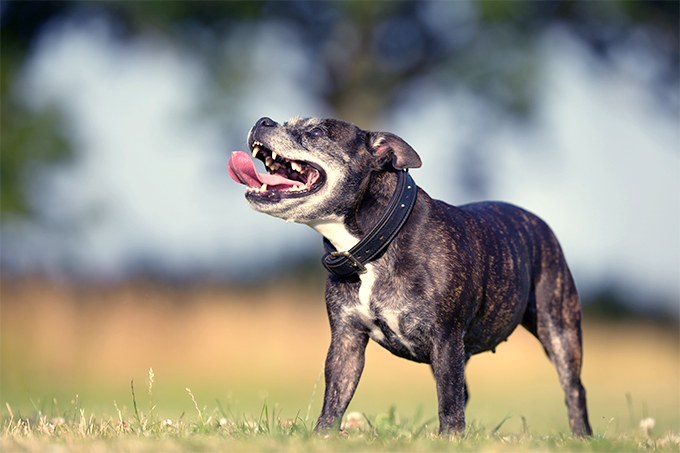
-
Staffordshire Bull Terrier Picture

-
Staffordshire Bull Terrier Picture

-
Staffordshire Bull Terrier Picture
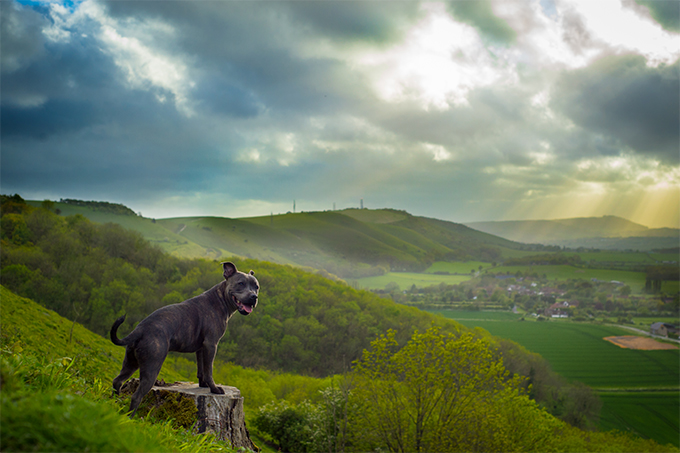
-
Staffordshire Bull Terrier Picture
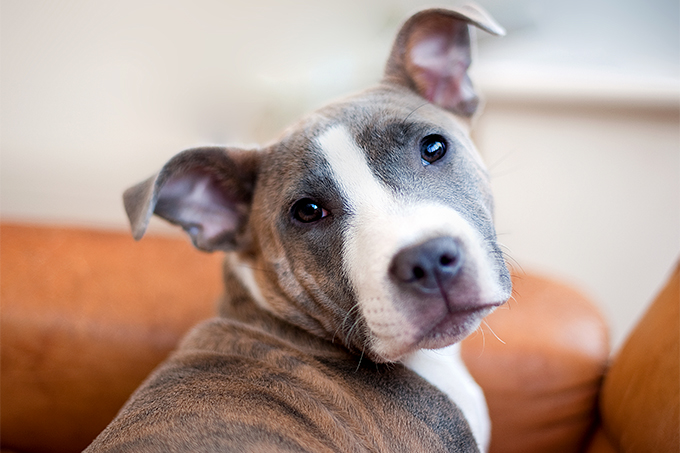
-
Staffordshire Bull Terrier Picture
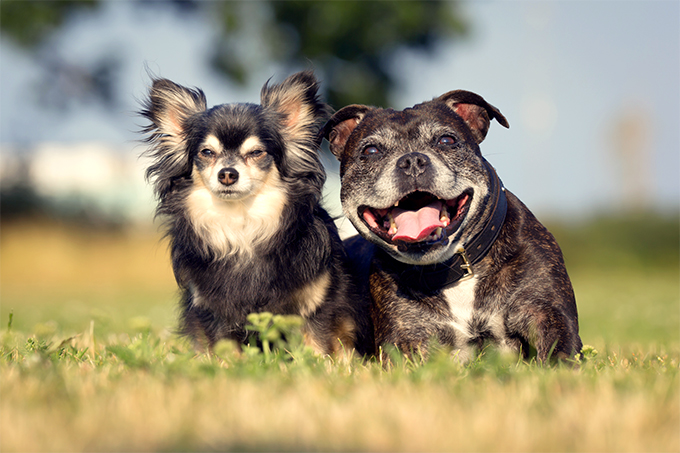
-
Staffordshire Bull Terrier Picture
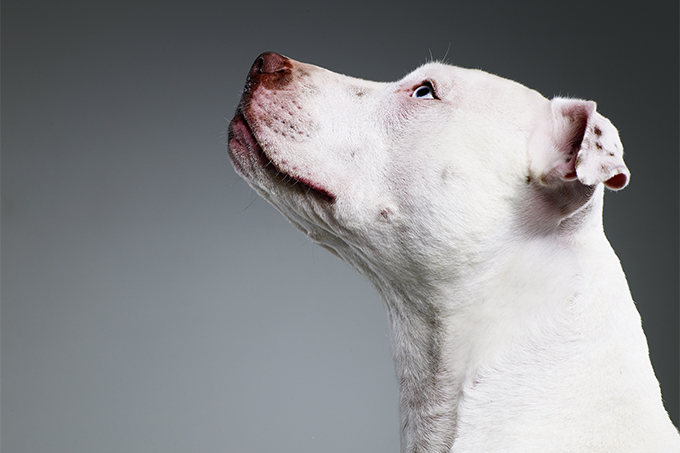
-
Staffordshire Bull Terrier Picture
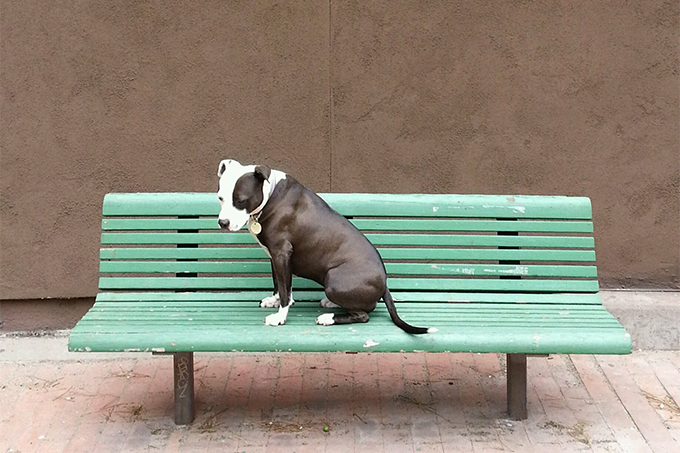
-
Staffordshire Bull Terrier Picture
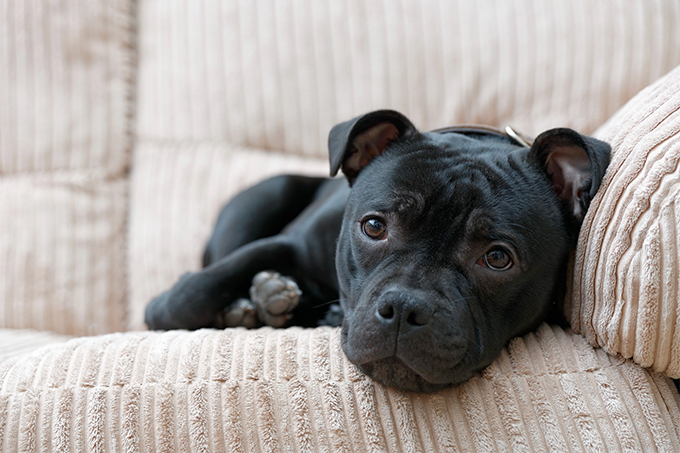
-
Staffordshire Bull Terrier Picture
